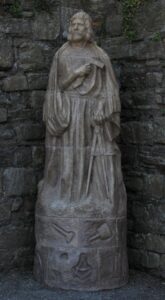
Employed by Edward I in the late 13th century as Master of the Kings Works in Wales, James of St. George was the architect and master builder of ten monumental castles in Wales. A 21st century visitor visiting these castles today cannot fail to be impressed by the epic scale of the walls and towers and one can only imagine the effect that these buildings would have had on medieval minds.
James’s skills were not only in the design and build of these castles but in organising men and materiel in an environment where transportation was primitive and the locals were distinctly hostile. His final project was the building of the castle at Beaumaris on the island of Anglesey in Wales. It was designed on his principle of ‘walls within walls’ and unlike some of his other castles did not have any constraints of geography or existing cities to spoil what was envisioned as a perfect fortress.
However, almost from the beginning work on the castle was troubled with financial difficulties and when Edward 1 went to war in Scotland, work all but stopped. £15,000 had been spent on Beaumaris when money ran out in 1298 and James wrote to Edward’s treasurers pleading for additional money. In what must be one of the first ever written examples of an Exception Report, James sent a letter to Edward’s treasurers explaining how the money had been used and why further expenditure was necessary.
“…we write to inform you that the work we are doing is very costly and we need a great deal of money. You should know… that we have kept on masons, stone cutters, quarrymen, and minor workmen all through the winter, and are still employing them, for making mortar and breaking up stone for lime; we have had costs bringing this stone to the site and bringing timber for erecting the buildings in which we are all now living instead of the castle; we also have 1000 carpenters, smiths, plasterers and navvies, quite apart from a mounted garrison of 10 men… , 20 crossbowmen… , and 100 infantry….”
He continued to explain to his paymasters the ongoing project burn which made his request for additional funds so urgent.
“In case you should wonder where so much money could go in a week, we would have you know that we have needed – and shall continue to need – 400 masons, both cutters and layers, together with 2000 minor workmen, 100 carts, 60 wagons and 30 boats bringing stone and sea coal; 200 quarrymen; 30 smiths; and carpenters for putting in the joists and floorboards and other necessary jobs. All this takes no account of the garrison mentioned above, nor of the purchase of material, of which there will have to be a great quantity… The men’s pay has been and still is very much in arrears, and we are having the greatest difficulty in keeping them because they simply have nothing to live on.”
And in a postscript which will resonate with project managers even after 800 years…
And, Sirs, for God’s sake be quick with the money for the works, as much as ever our lord the king wills; otherwise everything done up till now will have been to no avail.
Substitute ‘our lord the king’ with Project Sponsor or Senior Responsible Officer and this could be the heartfelt plea added to every request for additional project funds remembering to credit James of St. George 1298.
James received his funding but financial troubles dogged construction and although work continued for almost 35 years the castle was never finished.